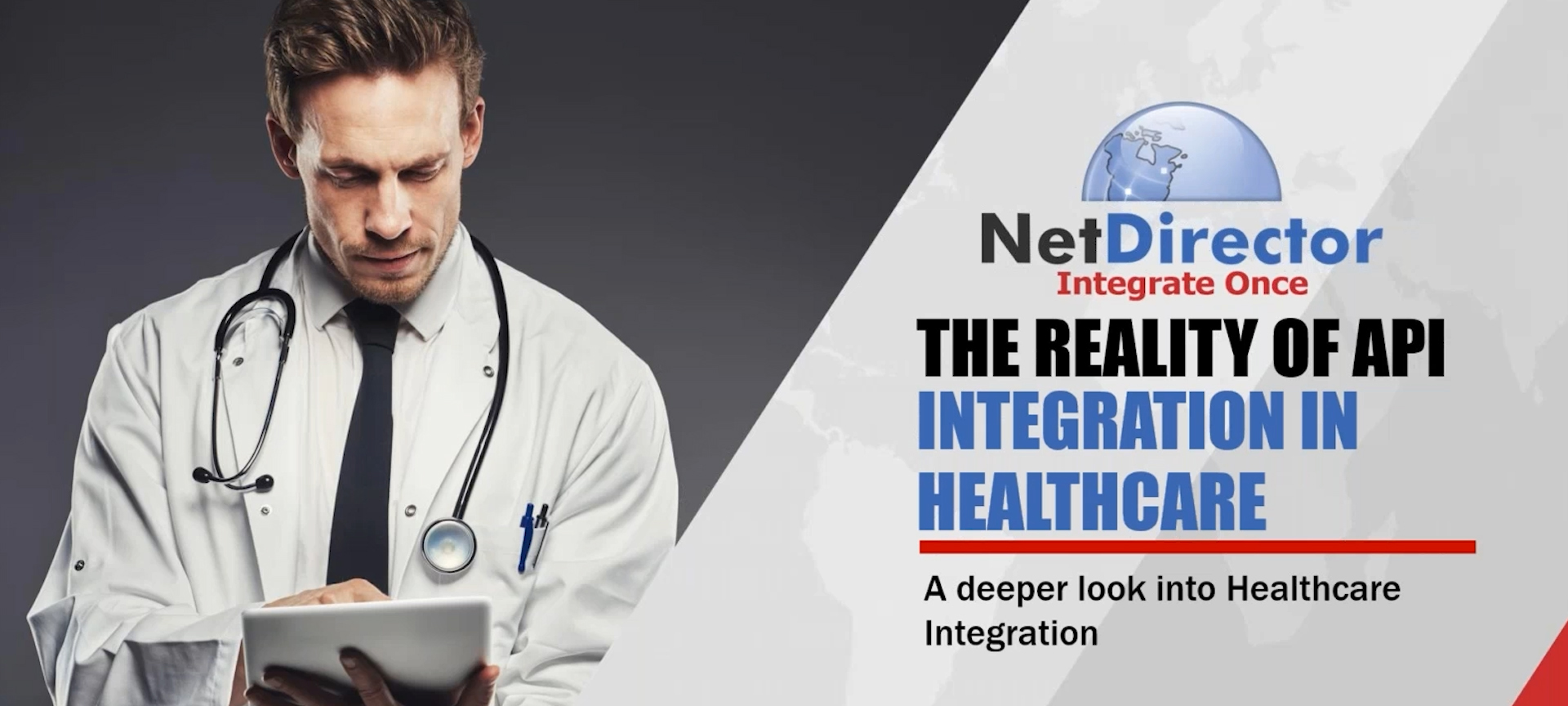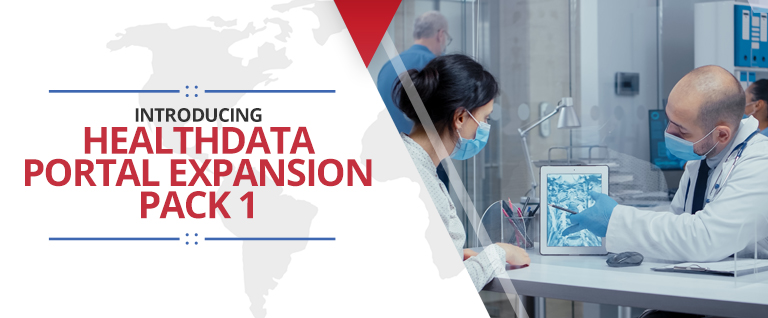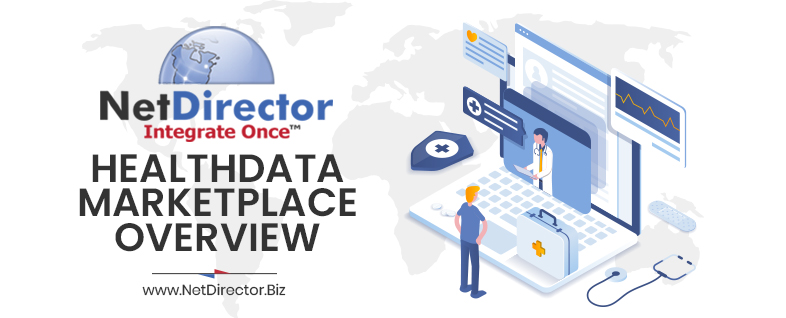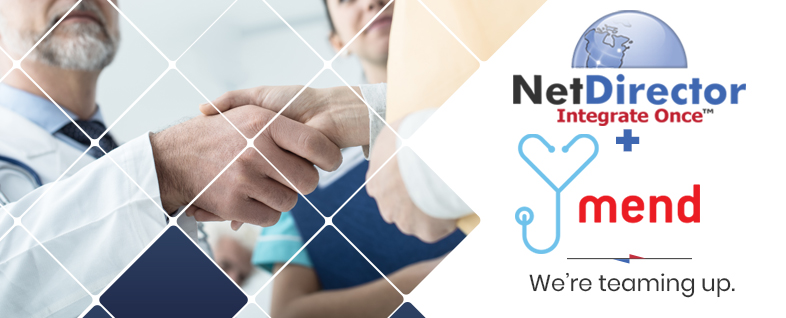The reality of API Integration in Healthcare can be misleading. To help identify these issues and show the strengths of an automated, cloud-based approach when it comes to integration, join Lynda McNally and Josh Schofer as they take a deeper dive into Healthcare Integration and the APIs involved in that process to answer your most important questions.
New Video: HDP Expansion Pack Details
We’re focused on bringing our customers the smoothest and most feature-rich experience possible. Our goal is to listen to our customers’ needs closely and develop new enhancements based on demand. After the first wave of feedback, we’ve been hard at work creating an expansion pack for our existing HealthData Portal, Including new features that provide our customers with better security, and functionality.
HealthData Portal Expansion Pack 1 Features:
Increased Security: We’ve now added a Multifactor Authentification.
Download Messages: We’ve added the ability to download or view individual messages being sent from your system to your trading partners.
Associate Messages: We’ve added the ability to associate multiple messages that may be in your ecosystem and view how that message travels through its lifecycle.
Interested in learning more about our HealthData Portal Expansion Pack? Contact our Healthcare Operations Manager Josh Schofer at Josh@NetDirector.biz or by phone at 813.343.0971 today to schedule a time to talk!
HealthData Marketplace
NetDirector provides a centralized data exchange for a growing network of subscribers in the Healthcare Industry. This list continues to expand as Hospitals, Physicians, Radiology/Imaging Centers, Labs and many more realize the value of automation through one centralized data marketplace versus managing a myriad of direct-connections with each individual trading partner. The following links provide a list of some of our current participants – new members are added all the time, and we can bring on new trading partners to suit your needs.
NetDirector Brings Automation and Integration to the Fight Against Opioids with North Carolina Medical Society and Project OBOT
Tampa, FL – November 12, 2019 – NetDirector, the leading cloud-based data exchange and integration platform, has been recruited by the North Carolina Medical Society Foundation to provide data integration for their virtual recovery and treatment program.
As a response to the national opioid epidemic (in which North Carolina is especially affected), in 2018 the North Carolina Medical Society Foundation created Project OBOT NC. This project delivers a virtual recovery and treatment program for those individuals suffering Opioid Use Disorder. This virtual treatment platform allows affordable treatment access even in remote areas of the state, without sacrificing significant time and cost investment to launch the campaign.
Along with their coalition of healthcare and technology experts, Project OBOT facilitates practitioners performing collaborative care which includes the need for integrations to data companies such as LabCorp, NCCARE360, the North Carolina Health Information Exchange (HIE), and various EHR systems.
Project OBOT selected NetDirector to provide these integrations based on a shared vision of rapid deployment, sustainable interoperability, and flexible utilization. Franklin Walker, Executive Director of Project OBOT, stated “NetDirector offered us an opportunity to quickly integrate to all of the critical data sources to provide the treating doctors access to a multi-disciplinary clinical input and other critical data.” He went on to add: “NetDirector’s offering prevented the need for our organization to hire expensive IT professionals, thus allowing us to direct more money towards treatment. We are pleased to welcome their service to our fight against this crisis.”
NetDirector now provides integration for clinical and patient data for several organizations allied in the fight against the continuing opioid crisis in the U.S. including EMR/EHR platforms, labs, controlled substance tracking databases, and more. Find out more about NetDirector’s existing marketplace of integrations on their website – new integrations are added based on client request and need.
Company Bio: NetDirector provides a secure cloud-based data and document exchange solution for the healthcare and mortgage banking industries to deliver seamless data integration between parties. NetDirector bridges gaps created by disparate systems & technologies by allowing companies at any location to share data & documents securely over a single internet connection with any other member of the ecosystem. Our approach allows trading partners to collaborate and exchange data in a seamless, bi-directional, real-time manner. With security and longevity as a focus, NetDirector is a certified HIPAA Compliant company, a 6-year member of the prominent Inc. 5000, and currently processes more than 10 million transactions per month.
NetDirector Teams up with Mend
NetDirector Teams with Mend to Bring Seamless Integration and Automation to their Healthcare Ecosystem
Continue readingNetDirector Goes Live with First Wave of Integrations with Industry-Leading Technology Provider GPM, Corp.
Tampa, FL – October 8th, 2019 – NetDirector, a cloud-based data exchange and integration platform, has partnered with leading long-term/post-acute care (LTPAC) technology provider GPM, Corp. and their EHR platform, GEHRIMED, to provide a powerful and modern solution to the challenges of interoperability. With the unique needs of long-term/post-acute care, GEHRIMED and NetDirector have teamed up to ensure that data associated with patient care in this critical sector can be utilized more rapidly and efficiently. The initial integration focuses on billing systems and the patient/billing information of GEHRIMED’s clients – the LTPAC providers that utilize GEHRIMED as their EHR solution.
Prior to integrating through NetDirector, GEHRIMED was responsible for maintaining individual one-to-one integrations with all their data trading partners. This meant building and servicing a broad variety of custom-designed interfaces between their platform and the other platforms utilized by their clients such as CompMed or AdvancedMD (two of the many billing platforms utilized by GEHRIMED clients). This development and maintenance meant significant internal resources were being devoted to integration, when the team at GEHRIMED knew they could better serve their customers by focusing on improving and maintaining their core EHR platform.
GEHRIMED opted to partner with NetDirector after recognizing that creating and maintaining complex integrations with each new and existing system would divert resources from their core mission – providing interoperable technology to LTPAC providers. GEHRIMED now leverages NetDirector’s flexibility, reliability and expertise to handle all their integration needs.
The cloud-based, zero-footprint integration allows GEHRIMED to send patient and billing information to multiple systems quickly and easily. Additionally, implementation is rapid for new trading partners, and the dedicated integration analyst that NetDirector provides GEHRIMED a highly valuable resource to expand their integration ecosystem. NetDirector analyst, with their deep domain expertise, function as an extension of GEHRIMED’s internal team regarding new client onboarding and ongoing support/consultation.
Cindy Ireland, Vice President of Development at GEHRIMED, said recently that “the NetDirector integration drastically reduces the potential for pain in the future, and makes getting our data from one place to the other secure with an easy repeatable process.” Ireland continued, “This integration allows us to focus on our own technology and client experience, while ensuring that providers can leverage GEHRIMED to provide the best possible patient outcomes and experience.”
The integration includes a bidirectional patient demographic interface that ensures patient information is synchronized throughout the various billing systems, and a unidirectional billing interface that sends charge information directly to the billing systems. Currently, the integration can manage data in a variety of formats and connection methods, including HL7 LLP, Web Services, SFTP, and both Json and XML formatting.
“Onboarding an industry leader like GEHRIMED and their trading partner network will be a valuable addition to our healthcare ecosystem,” said Harry Beisswenger, CEO of NetDirector. “GEHRIMED has been a great partner to work with during our implementation phase and now are starting to realize the full benefits of our ‘integrate once’ approach. As our healthcare marketplace expands, other providers and technology vendors will have an even easier time getting their data flowing when and where they need it with a single integration.”
Company Bio: NetDirector provides a secure cloud-based data and document exchange solution for the healthcare and mortgage banking industries to deliver seamless data integration between parties. NetDirector bridges gaps created by disparate systems & technologies by allowing companies at any location to share data & documents securely over a single internet connection with any other member of the ecosystem. Our approach allows trading partners to collaborate and exchange data in a seamless, bi-directional, real-time manner. With security and longevity as a focus, NetDirector is a certified HIPAA Compliant company, a 6-year member of the prominent Inc. 5000, and currently processes more than 10 million transactions per month.
The Biggest Concerns Facing Healthcare CIOs
Data, data, everywhere. That’s a reality across industries, but likely most impactful in healthcare, which is projected to become the fastest rising sector among data-handling businesses by 2025. “The growth reflects advancements in healthcare analytics and imaging technology, as well as the increasing amount of real-time data created in medical care,” a report from research firm IDC says.
As healthcare organizations immerse themselves in data, CIOs confront new challenges while leading IT initiatives expected to deliver heightened value. They’re tasked with converting technology investments into strategic assets built on “innovation and digital transformation” — and, simultaneously, addressing the informational needs of clinicians and other front-line staff.
Among their major pain points:
- Leveraging data to drive care decisions and help patients stay on-track in managing their own health.
- Coordinating and securing the flow of protected information among intertwined and expanding health systems.
- Using analytics to uncover cost and quality indicators tied to specific medical conditions.
- Managing the technology infrastructure to support a growing array of digital health and administrative connections for patients, who anticipate responsiveness on par with consumer-oriented e-commerce systems.
And just over the horizon, provider organizations will reach key pivot points regarding data stewardship. Sixty percent of recently surveyed healthcare CIOs said health data would be stored in a hybrid/private cloud within three years. Nearly half predict that their use of telehealth will increase over the same timeframe. Also ramping up are mobile-enabled workflows in areas such as medication administration and clinical documentation; they will become core parts of all-encompassing electronic health record systems.
Why Interoperability Matters
On this steep slope toward data-rich environments, hospital CIOs should be applauded for incremental gains in improving interoperability, but they have to pick up the pace, according to Steve Burrill, U.S. healthcare leader for advisory firm Deloitte.
As providers enter into more risk-based contracts with payers, “they need to be able to seamlessly share data to reduce costs and improve outcomes,” writes Burrill. “All stakeholders — the patient, the clinician, the hospital, the drug and device manufacturer and the health plan — should be committed to interoperability.”
CIOs know they must deploy technology that will put to use troves of collected data. They’re actively searching for the biggest issues data can solve, and determining how and when to present it to the right audiences in the proper context to benefit the entire healthcare ecosystem. For example, leading-edge organizations are building patient profiles that can tap predictive models, allowing doctors to more effectively anticipate, diagnose and treat disease. The anticipated payoff would come, in large part, by reducing hospital readmissions. Additional cost savings could accrue through accurate forecasting of facility demands, such as operating room capacity, and optimized staffing.
“The common theme here is that there’s a tremendous amount of digital data available in hospitals and in the broader healthcare community that has never been available before,” observes Mark Wolff, chief health analytics strategist for software developer SAS Institute. “We have algorithms that produce incredible analysis efficiently with a high degree of confidence — and now we’re using that to tackle problems we’ve all been dealing with for quite some time in a deeper, more robust way.”
In like fashion, CIOs are looking to leverage technology that helps them problem-solve, adding more strength to their IT teams without consuming accompanying staffing costs and resources. NetDirector’s HealthData Exchange can help remove obstacles associated with sharing clinical and billing data. The cloud-based platform normalizes data to standard formats to achieve seamless interoperability.
Find out how to remove the bottlenecks of traditional interfacing by contacting us or requesting a free demo.
Healthcare Data Integration Leads to Better and More Affordable Care
The United States continues to outspend other industrialized countries on healthcare, mainly due to higher drug prices, increasing doctor/nurse salaries, rising hospital administrative costs and escalating fees for many medical services, according to a newly published study from the Johns Hopkins Bloomberg School of Public Health.
Per capita U.S. healthcare spending is a stark outlier, 25 percent above the next most expensive nation (Switzerland) and an astounding 145 percent over the median for countries in the Organization for Economic Cooperation and Development (OECD), from which the Johns Hopkins researchers drew their data.
Unfortunately, extravagance doesn’t translate to better healthcare access for U.S. patients. In fact, just the opposite is true. The U.S. trails OECD median totals in numbers of practicing physicians and nurses per 1,000 population, as well as new medical school graduates per 100,000 population and acute care hospital beds per 1,000 population.
What can be done to counter and redirect these trends toward a sustainable path of affordable and accessible care? The answers appear to be a mix of organizational pragmatism and technological leverage.
Operational Integration
Some health systems see vertical alignment with managed care as an important first step toward reining in costs. For example, earlier this month, West Virginia University Health System (operating as WVU Medicine) and The Health Plan announced their intent to form “a fully integrated healthcare delivery and financing system” for patients in the Mountain State. The Health Plan, a nonprofit managed care organization, will become a subsidiary of WVU Medicine.
WVU Health CEO Albert Wright says true cost control and coordination can be achieved through provider-payer alignment. An integrated model enables providers to care for the sick while also emphasizing prevention and wellness among the general population.
Advisory firm Deloitte notes that provider-sponsored health plans make up only about 10 percent of the total market; however, such plans have tremendous promise based on built-in advantages over sometimes adversarial provider-payer affiliations. “They control key parts of the delivery system and have more engaged relationships with their patient consumers,” states a Deloitte briefon provider-health plan integration. “They can employ their market beachheads to the health plan arena to generate new income streams that fuel improvements in their clinical effectiveness and patient experience.”
Technology Makes a Difference
University of Pittsburgh Medical Center (UPMC) has more than 20 years’ experience running its own health plan in Western Pennsylvania. Enrollment in UPMC insurance products now exceeds 3.3 million members, making it one of the largest and fastest-growing provider-owned health plans in the nation. “The partnership generally focuses on opportunities to improve care first, and then is followed by development of payment models to support those efforts,” a UPMC article explains.
Particularly significant has been UPMC’s progress in addressing the scourge of opioid addiction in its patient community. According to UPMC, data silos have been integrated to make real-time information available to clinical decision-makers. Health plan data generates profiles and benchmarks of provider prescribing behavior, identifies patients with opiate usage patterns suggestive of dependence or abuse, and shares with emergency department physicians a view of opiate prescription refills at all pharmacies. In the second half of 2017, UPMC providers lowered opioid prescribing by 18 percent compared to the prior year.
From a broader view, health IT integration initiatives serve as cultural forces in making patient information available electronically when and where needed. In doing so, health IT improves care quality while making its delivery more cost-effective. Providers directly benefit from having accurate and complete information about a patient’s health, according to the Agency for Healthcare Research and Quality. Whether responding to a routine visit or a medical emergency, providers who can access integrated information have the ability to diagnose problems sooner, reduce medical errors, and administer safer care at lower costs.
What’s more, health IT integration supports improved care coordination and dissemination of patient status information with family members and other caregivers.
NetDirector’s HealthData Exchange platform seamlessly automates and secures the sharing of information and documents across the healthcare ecosystem, from small physician practices to multi-facility health systems and points in between. In an industry gearing up for more prevalent integration, NetDirector’s technology brings the advantage of a reliable and tested platform.
To learn more about HealthData Exchange, contact us or request a free demo.
Healthcare IT Boosts Consumer Engagement Component
Healthcare IT Boosts Consumer Engagement Component
Healthcare providers are undergoing a fundamental transformation by making their services increasingly accessible and adaptable to consumer preferences. Over half of all patient transactions are already handled online, virtually or through an app, according to tech giant Oracle. And that percentage will only grow as a rising share of younger consumers demand new ways to address their healthcare needs through mobile connections and on-demand systems.
“People are taking more ownership of their healthcare, and they expect user-friendly technologies to help them do so,” says Paul Black, CEO of electronic health record (EHR) vendor Allscripts. “The solutions that deliver what consumers want are the ones that will be successful.”
Competing with Technology Titans
Healthcare has already drawn deep interest and investment from digital-sector headliners such as Amazon and Google. These non-traditional participants seek to disrupt the marketplace by helping consumers manage wellness and engage with providers, Black points out. For example, last year Amazon began offering a discount on its Prime delivery service to Medicaid beneficiaries, and now — through the acquisition of online pharmacy PillPack — has rolled out one-day free shipping on prescriptions to Prime customers in many ZIP codes across the country.
Accordingly, healthcare-entrenched companies like Allscripts know they must keep pace with consumer-focused technologies, in particular by expanding mobile outreach capabilities. Consumers want to be active in their own care “before, during and after visits” through mobile connections, emphasizes Black.
Along those lines, Allscripts’ recently enhanced FollowMyHealth patient platform enables SMS messages and alerts without consumers having to log into a provider’s portal.
Ephraim McDowell Health, an integrated healthcare delivery system serving about 120,000 residents in central Kentucky, will use FollowMyHealth as part of a “pro-consumer” strategy to make it convenient for patients to stay informed about their health. The health system favors a unified approach to patient engagement over deployment of multiple, disconnected smartphone apps.
“We as an industry must be prepared for the evolving healthcare IT landscape and start now on creating intuitive access to our services, a simplified method of enabling personalized outreaches, and improve how we coordinate a patient’s care journey,” explains Gary Neat, CIO at Ephraim McDowell.
Allscripts reports more than 40 million patients nationwide have connected with providers through FollowMyHealth. The company says clients using the technology have actively engaged with up to 70 percent of patients through the platform.
Following the Trendlines
Newly released findings from a survey of 1,000 healthcare leaders rank consumerism as a top-level concern across the industry. The report recognizes the transformation of patients to consumers who seek lower costs and greater convenience from providers. As a result, “providers will have to work harder than ever to find and retain their patient populations,” the survey concludes.
Additionally, personalized patient engagement will accelerate population health initiatives during 2019, according to Becker’s Hospital Review. In particular, voice-driven consumer communications that mimic natural conversations — whether reminders to schedule appointments and screenings or to prepare for an upcoming procedure — will empower patients to make informed decisions and take action about their health. The goal is to improve outcomes “on a scale that would be impossible with existing staff,” Becker’s notes.
As providers pursue new ways to engage with consumers, new components will be added to existing technologies and CIOs’ responsibilities. Knowing that core systems and data-exchange mechanisms are running at peak efficiency in a truly integrated fashion will free up health IT executives to apply their expertise and resources to emerging consumer-centric technologies.
NetDirector’s cloud-based HealthData Exchange complements current IT investments while streamlining clinical workflow and communications throughout a provider’s extended community. To learn more about the platform, contact us or request a free demo.
How Artificial Intelligence Will Influence Healthcare Policy
A prominent part of healthcare’s future rides the still-cresting wave of innovation in artificial intelligence (AI). Half a decade ago, AI hardly made a ripple in the realm of healthcare applications. But by the end of 2018, equity funding for healthcare AI startups had reached $4.3 billion, with deal activity (576 transactions) surging past all other industries since 2013, according to research firm CB Insights.
A separate analysis from faculty experts at Boston-based health system Partners HealthCare concludes that AI will deliver a wide range of tangible benefits in care delivery by 2020. Radiology leads the way, with emerging applications for rapid disease detection, complex image assessment, and cost-effective clinical testing. Partners also expects AI breakthroughs in:
- identifying patients at high risk for self-harm;
- automation of high-volume tasks for triaging patients;
- monitoring brain health to predict seizures and onset of dementia;
- facilitating health information exchange;
- streamlining coding and billing processes;
- enabling voice-command technology through natural language processing and smart appliances; and
- smartphone-based therapies for mental health conditions such as depression and substance abuse.
Real-Time Activity
Impending opportunities appear close to reaching fruition. Big-name vendors already have their hands in the AI market, with the recent HIMSS19 conference giving glimpses of new product pathways.
For instance, IBM Watson Health projects that medical data will double every 73 days by 2020, while physicians will spend twice as much time on administrative tasks than on interactions with patients. Working with partners, the company offers AI solutions aimed at identifying claims fraud and waste, decision-support tools that provide evidence-based drug information within a hospital’s workflow, and a mobile personal-assistant app that provides diabetes patients with actionable glucose insights.
Elsewhere, EHR provider Cerner is using AI within its suite of systems to identify gaps and inconsistencies in patient records. The firm believes AI-powered workflows will bring improvements to patient safety and leverage technology to counteract physician fatigue and frustration with EHR complexity.
These types of initiatives “can get us to what we’ve been missing for decades now, which is the true care in healthcare,” says futurist and practicing cardiologist Eric Topol, MD, author of Deep Medicine: How Artificial Intelligence Can Make Healthcare Human Again. Topol explains that AI will not only reduce errors made by doctors but also help them make better care decisions as a matter of course.
Policies for AI Progress
Still, industry observers recognize that AI’s progress will depend in part on careful stewardship in its implementation. At Cleveland Clinic, Susannah Rose, associate chief experience officer, emphasizesthat AI applications need to be closely monitored and rigorously tested. The policy is shaping up to “keep what needs to be human, human — and then come back in and automate those things that don’t need the human touch,” Rose notes.
Additionally, the American Medical Association (AMA) has gone on record in support of “thoughtfully designed, high-quality, clinically validated healthcare AI.” The development process should integrate the perspectives of practicing physicians, according to an AMA policy statement. Specifically, AMA backs AI developed under best practices in user-centered design, where users are physicians and other members of the care team. The technology should also conform to standards for reproducibility and safeguard the privacy and security of individuals’ personal information.
NetDirector stays certified and up-to-date on common policy and compliance needs in healthcare — such as those currently taking shape with AI. The company structures its HealthData Exchange platform so that providers can focus on delivering care, instead of managing technology.
For more information on how AI may interact with current technologies and future developments, please contact us or request a free demo.











